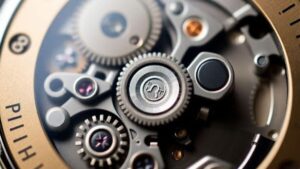TECHNOLOGY
The Ultimate Guide to Understanding Watch Movements and Mechanisms

Watches are more than just accessories; they are intricate machines that tell time. Understanding how watch movements work is essential for anyone interested in horology. This guide will explore the different types of watch movements, their history, and their significance in the world of watches.
Key Takeaways
- A watch movement is the mechanism that powers a watch and makes it tick.
- There are three main types of watch movements: mechanical, automatic, and quartz.
- Mechanical movements are prized for their craftsmanship and can last a lifetime with proper care.
- Automatic movements wind themselves through the motion of the wearer’s wrist, making them convenient.
- Quartz movements are battery-operated and known for their accuracy and affordability.
Understanding the Basics of Watch Movements
What is a Watch Movement?
A watch movement, also known as a caliber, is the mechanism that powers a watch. It is essentially the engine that makes the watch function. This movement controls how the hands move and powers additional features like calendars and chronographs.
The Importance of Watch Movements
Understanding watch movements is crucial for anyone interested in watches. Here are some key points:
- Accuracy: The type of movement affects how accurately a watch keeps time.
- Maintenance: Different movements require different levels of care and servicing.
- Value: The craftsmanship involved in the movement can significantly influence a watch’s value.
Common Misconceptions About Watch Movements
Many people have misunderstandings about watch movements. Here are a few:
- All watches are the same: Different movements offer various features and levels of accuracy.
- Quartz is always better: While quartz movements are accurate, many collectors prefer mechanical movements for their artistry.
- You need to wind all watches: Automatic watches wind themselves through wrist movement, unlike manual ones that require winding.
Understanding the basics of watch movements can enhance your appreciation for these intricate timepieces.
Mechanical Movements: The Heart of Traditional Watchmaking

Mechanical movements are the oldest type of watch mechanisms, dating back to the 16th century. They are often seen as the heart of traditional watchmaking because of their intricate designs and craftsmanship.
History of Mechanical Movements
- The first mechanical watches were crafted as pocket watches.
- They used a combination of gears and springs to keep time.
- Over the years, watchmakers have refined these designs, making them more accurate and reliable.
How Mechanical Movements Work
Mechanical movements operate using a coiled metal spring called a mainspring. Here’s how they function:
- Winding: The wearer winds the watch using a crown, which tightens the mainspring.
- Energy Release: As the mainspring unwinds, it releases energy through a series of gears.
- Timekeeping: The escapement regulates this energy, allowing the watch hands to move at precise intervals.
| Component | Function |
| Mainspring | Stores energy when wound |
| Escapement | Controls the release of energy |
| Balance Wheel | Oscillates to keep time |
Advantages and Disadvantages of Mechanical Movements
Advantages:
- No batteries required, making them eco-friendly.
- Often considered works of art due to their craftsmanship.
- Can last a lifetime with proper care.
Disadvantages:
- Requires regular winding (for manual types).
- More sensitive to shocks and temperature changes.
- Generally less accurate than quartz movements.
Mechanical movements are not just timekeepers; they are a testament to the artistry and skill of watchmakers throughout history.
Automatic Movements: Innovation in Motion
The Evolution of Automatic Movements
Automatic movements, also known as self-winding movements, have transformed the way we think about watches. These movements harness energy from the wearer’s wrist motion, making them convenient and user-friendly. The first automatic watch was created in the late 1700s, and since then, they have evolved significantly.
How Automatic Movements Differ from Mechanical Movements
While both automatic and manual movements are types of mechanical movements, they operate differently:
- Manual Movements: Require daily winding by hand.
- Automatic Movements: Wind themselves through wrist motion.
- Energy Source: Automatic movements use a rotor to convert movement into energy, while manual movements rely solely on hand winding.
Popular Automatic Movement Watches
Here are some well-known watches that feature automatic movements:
- Rolex Submariner
- Omega Seamaster
- Tag Heuer Carrera
Automatic movements have made watches easier to maintain, allowing wearers to enjoy their timepieces without the hassle of daily winding.
Quartz Movements: Precision and Affordability
Introduction to Quartz Movements
Quartz movements are a type of watch mechanism that uses a battery to keep time. They are known for their incredible accuracy and low maintenance needs. Instead of winding a spring, quartz watches rely on a small battery that sends electricity through a quartz crystal, causing it to vibrate at a precise frequency. This vibration helps the watch keep time accurately.
How Quartz Movements Work
The basic operation of a quartz movement can be summarized in these steps:
- Battery Power: A battery sends an electrical charge to the quartz crystal.
- Crystal Vibration: The quartz crystal vibrates at a frequency of 32,768 times per second.
- Timekeeping: These vibrations are converted into regular pulses that move the watch hands.
Pros and Cons of Quartz Movements
| Pros | Cons |
| Highly accurate | Requires battery replacement |
| Low maintenance | Less craftsmanship than mechanical watches |
| Affordable to produce | Limited features compared to some mechanical watches |
Choosing the Right Movement for Your Replica Rolex
When selecting a movement for your replica Rolex, it’s essential to consider several factors to ensure you get the perfect Rolex experience. Here are some key points to keep in mind:
Factors to Consider When Choosing a Movement
- Type of Movement: Decide between mechanical, automatic, or quartz. Each has its own benefits and drawbacks.
- Budget: Higher quality movements often come at a higher price. Determine how much you are willing to spend.
- Purpose: Consider how you will use the watch. Is it for daily wear, special occasions, or collecting?
Comparing Different Movements for Replica Rolex
| Movement Type | Accuracy | Maintenance | Cost |
| Mechanical | Moderate | High | High |
| Automatic | High | Moderate | Moderate |
| Quartz | Very High | Low | Low |
Expert Tips for Selecting the Best Movement
- Research: Look into the different types of movements and their features.
- Ask Experts: Consult with watchmakers or collectors for their recommendations.
- Test It Out: If possible, try on watches with different movements to see what feels right.
Choosing the right movement is crucial for enjoying your watch. A well-chosen movement can enhance your experience and ensure your fake Rolex serves you well for years to come.
Maintaining and Servicing Your Watch Movement
Routine Maintenance Tips
- Wear your watch regularly: This helps keep the movement running smoothly.
- Keep it clean: Wipe the watch with a soft cloth to remove dirt and moisture.
- Avoid extreme conditions: Keep your watch away from high temperatures and humidity.
Signs Your Watch Needs Servicing
- Inaccurate timekeeping: If your watch is losing or gaining time.
- Strange noises: Any unusual sounds coming from the watch.
- Moisture inside the case: This can damage the movement.
Finding a Reliable Watch Service Provider
- Research local watchmakers: Look for reviews and recommendations.
- Check for certifications: Ensure they are qualified to work on your type of watch.
- Ask about warranties: A good service provider will offer a warranty on their work.
Exploring Complications and Features in Watch Movements
Understanding Watch Complications
Watch complications are extra features in a watch that go beyond just telling time. They can make a watch more useful and interesting. Many luxury brands, like Seiko x, incorporate these complications to enhance both functionality and style, giving wearers the look and feel of high-end timepieces without the premium price tag. Here are some common complications:
- Date Display: Shows the current date.
- Chronograph: A stopwatch feature that measures time intervals.
- Moon Phase: Displays the current phase of the moon.
Complications can add both functionality and value to a watch.
Popular Features in Modern Watches
Modern watches often come with various features that enhance their usability. Some popular features include:
- Water Resistance: Protects the watch from water damage.
- Luminous Hands: Makes it easy to read the time in the dark.
- Smart Features: Some watches can connect to smartphones for notifications.
How Complications Affect Watch Value
The presence of complications can significantly influence a watch’s value. Here’s how:
| Type of Complication | Impact on Value |
| Simple Date | Moderate |
| Chronograph | High |
| Tourbillon | Very High |
Conclusion
In summary, understanding watch movements is essential for anyone interested in timepieces. Whether you prefer the classic charm of mechanical watches, the convenience of automatic ones, or the precision of quartz, each type has its unique features and benefits. By knowing how these movements work, you can make better choices when selecting a watch that fits your style and needs. Remember, a watch is not just a tool for telling time; it’s a blend of art, science, and history that reflects your personality. So, the next time you wear a watch, appreciate the intricate mechanisms that make it tick.
Frequently Asked Questions
What exactly is a watch movement?
A watch movement, also called a caliber, is the mechanism inside a watch that makes it tick. It controls how the hands move and powers features like calendars and timers.
Why are watch movements important?
Watch movements are crucial because they determine how accurate a watch is and how often it needs to be wound or serviced.
What are the main types of watch movements?
The three main types of watch movements are mechanical, automatic, and quartz. Each type works differently and has its own benefits.
How does a mechanical movement work?
Mechanical movements use gears and springs to keep time. They need to be wound by hand to store energy.
What is an automatic movement?
An automatic movement is a type of mechanical movement that winds itself using the motion of your wrist.
What makes quartz movements different?
Quartz movements use a battery and are generally more accurate than mechanical movements. They rely on a crystal to keep time.
TECHNOLOGY
Clogged and Costly: How Dirty Air Filters Lead to AC Repairs

Air conditioning systems are often taken for granted until something goes wrong. Most people expect their AC to cool the home efficiently without realizing that something as simple as a dirty air filter can be the root cause of many system breakdowns. Neglecting this one part of your HVAC system can create a ripple effect that strains its performance, reduces indoor air quality, and, most importantly, leads to costly repairs. A clean air filter may seem minor, but it plays a crucial role in maintaining airflow, protecting internal components, and preserving system longevity. We will explore how dirty air filters can slowly damage your AC, forcing repairs that could have been easily avoided with regular maintenance. Understanding the risks and symptoms associated with clogged filters can help you avoid unexpected expenses and ensure your air conditioning system operates smoothly throughout the summer.
Why Dirty Filters Trigger AC Repairs
Restricted Airflow Strains System Components
When an air filter becomes clogged with dust, dander, and debris, it restricts the amount of air that can pass through the system. Air conditioners rely on steady airflow to regulate indoor temperatures and maintain efficiency. When airflow is blocked, the system must work significantly harder to draw in and circulate air, placing strain on major components, such as the blower motor and compressor. Over time, this extra effort can cause these components to overheat or wear down faster than expected. Blower motors are particularly vulnerable to damage when they operate under constant pressure, and replacing them is far more expensive than replacing a dirty filter.
In extreme cases, restricted airflow can cause the AC system to short cycle—turning on and off repeatedly—which leads to further mechanical stress and a significant increase in energy bills. For many homeowners, this often results in needing air conditioning repair in Arlington, as what begins as a minor buildup of debris can quietly snowball into a complete system failure if left unchecked.
Frozen Evaporator Coils Become a Hidden Menace
Another way dirty air filters lead to AC repairs is by triggering evaporator coil freeze-ups. Evaporator coils are responsible for absorbing heat from your indoor air and must have unrestricted airflow to function properly. When the filter is dirty, the reduced air volume causes the coils to become too cold. This, in turn, leads to condensation forming on the coils, which can quickly freeze. A frozen coil might sound like a cooling benefit, but it’s one of the most damaging problems your system can face.
As ice builds up, the coils can crack or cause the compressor to malfunction—two repairs that are notoriously costly and time-consuming. Even if the ice thaws, the moisture left behind can lead to mold or corrosion. Once these coils are compromised, your AC can no longer cool efficiently and might need to be shut down completely for repair or replacement. All of this damage, stemming from restricted airflow, reinforces the importance of keeping filters clean.
Dust and Debris Contaminate Internal Components
When a filter becomes saturated and can no longer trap airborne particles effectively, dust and debris begin to slip past and enter the system. These particles settle on coils, motors, fans, and other internal parts, making everything work harder and less efficiently. Accumulated dust can cause electrical connections to fail, reduce the lubricity of moving parts, and even create fire hazards if enough buildup reaches heated components.
Additionally, excessive dust can affect thermostat sensors and internal feedback loops, leading to poor temperature control. Dirty internal components force your AC to run longer cycles and use more power while providing less cooling comfort. Over time, these conditions increase the likelihood that you’ll need a professional to dismantle and clean the unit or replace malfunctioning parts.
Dirty Filters Lower Indoor Air Quality and Trigger Complaints
While not a direct mechanical repair, poor indoor air quality caused by a clogged filter often prompts homeowner complaints and service calls. A dirty filter can no longer effectively capture allergens, dust, pollen, or pet hair. These particles remain in circulation, leading to stuffy rooms, breathing discomfort, and more frequent allergy symptoms. In severe cases, the buildup may encourage the development of mold spores or bacteria inside the system, especially when combined with excess moisture from frozen coils. This contamination prompts many homeowners to call for inspections, thinking there’s a major mechanical failure when in reality, the problem started with neglect of the filter. Technicians may still need to disassemble parts of the unit to clean out the debris, making it a repair situation nonetheless. In essence, the discomfort triggered by poor filtration often results in real service expenses, even if the root issue is more about cleanliness than hardware.
A dirty air filter may not seem like a serious threat at first glance, but it sets off a chain reaction of issues that can severely compromise your air conditioning system. From blocked airflow to frozen coils and internal contamination, the damage caused by a clogged filter often goes unnoticed until it’s too late. Each of these problems puts added stress on vital components, raises energy consumption, and leads to expensive service calls that could have been easily prevented. As we have seen, dirty filters are a silent culprit behind many AC repair situations, robbing your home of comfort and your wallet of peace of mind. Staying on top of filter replacements is one of the simplest yet most effective ways to protect your investment and ensure your cooling system stays reliable.
TECHNOLOGY
Unraveling the Working Principle of Portable Power Stations

In a world where portable electronics and off – grid power needs are on the rise, portable power stations have become essential devices. From keeping your smartphone charged during a camping trip to powering essential appliances during a power outage, these compact units offer convenient and reliable electricity on the go. But have you ever wondered how they actually work? Understanding the working principle of portable power stations not only helps you make an informed purchasing decision but also enables you to use them more effectively. This article will take you through the inner workings of these remarkable power – providing devices.
Energy Storage: The Heart of Portable Power Stations
Battery Types and Their Role
At the core of every portable power station is a battery, which serves as the energy storage unit. Lithium – ion batteries are the most commonly used due to their high energy density, long lifespan, and relatively lightweight design. They store electrical energy in the form of chemical energy through an electrochemical process. When the power station is being charged, lithium ions move from the positive electrode to the negative electrode, where they are stored. During discharge, the ions flow back to the positive electrode, releasing electrical energy in the process.
Lead – acid batteries, although bulkier and heavier, are also used in some power stations. They work on a similar principle but use lead and sulfuric acid to store and release energy. Lead – acid batteries are known for their ability to handle high – current discharges, making them suitable for powering devices that require a sudden burst of energy.
Battery Management System (BMS)
A Battery Management System (BMS) is an integral part of a portable power station’s energy storage system. The BMS monitors the battery’s state, including its voltage, current, and temperature. It ensures the battery operates within safe parameters, preventing over – charging, over – discharging, and overheating. For example, if the battery’s temperature rises too high during charging, the BMS will reduce the charging current or even stop the charging process to protect the battery. Additionally, the BMS helps to balance the charge among individual battery cells, prolonging the overall lifespan of the battery pack.
Charging and Power Output Mechanisms
Charging the Power Station
Portable power stations can be charged through various methods. The most common way is via a wall outlet, where an AC – DC adapter converts the alternating current (AC) from the outlet into direct current (DC) to charge the battery. Some power stations support fast charging technology, which increases the charging current to reduce the overall charging time.
Solar charging is another popular option, especially for outdoor use. Solar panels convert sunlight into DC electricity, which is then regulated and used to charge the power station’s battery. This method is eco – friendly and allows for off – grid charging. Car charging, using the vehicle’s 12V power outlet, is also available for many power stations, providing a convenient way to recharge during road trips.
Providing Power to Devices
When it’s time to use the stored energy, the power station converts the DC power from the battery into the appropriate form for the connected devices. For USB – powered devices like smartphones and tablets, the DC power is directly supplied through the USB ports. For AC – powered devices such as laptops and small appliances, an inverter inside the power station converts the DC power into AC power. The power station also has different types of ports and sockets, each with specific voltage and current ratings, to ensure compatibility with a wide range of devices.
Conclusion
In conclusion, portable power stations operate through a combination of energy storage, charging, and power output mechanisms. Understanding how these components work together gives you a deeper appreciation for the technology behind these devices. Whether you’re using a portable power station for camping, emergencies, or daily convenience, this knowledge can help you choose the right model, use it safely, and make the most of its capabilities.
BUSINESS
Dados as Data: How This Concept is Transforming Analytics

Introduction to Dados as Data
In today’s fast-paced digital landscape, the way we think about data is changing. Enter “dados as data,” a concept that’s making waves in analytics. This innovative approach redefines how businesses and organizations leverage information to gain insights and make informed decisions. As traditional methods give way to this fresh perspective, we’re witnessing a transformation that promises not just improved accuracy but also enhanced strategic agility.
Imagine being able to extract deeper meanings from your datasets, unlocking hidden patterns and correlations that were once elusive. The shift towards viewing dados as data invites us into an exciting realm of possibilities for analysis and interpretation. It’s time to explore what this means for the future of analytics and how it can reshape our understanding of information management in the years ahead.
What is Dados as Data?
Dados as Data refers to a transformative approach in the realm of analytics. It shifts the focus from merely collecting data points to understanding and leveraging those points effectively.
This concept emphasizes treating all types of data—structured, unstructured, qualitative, and quantitative—as valuable assets. Rather than viewing them in isolation, Dados as Data encourages integration across various sources.
By fostering a holistic perspective on information, organizations can uncover hidden patterns and insights. This enables more informed decision-making processes.
Additionally, this framework supports real-time analysis and agile responsiveness in businesses. The aim is not just to gather statistics but to derive actionable intelligence that drives growth and innovation.
How is Dados as Data Transforming Analytics?
Dados as Data is reshaping the analytics landscape by redefining how organizations interpret and utilize information. This approach emphasizes not just raw data but also the context surrounding it.
With Dados as Data, businesses can derive deeper insights from their datasets. By integrating diverse data sources, they gain a holistic view of operations and customer behavior. This connectivity fosters more accurate predictions and enhances decision-making processes.
Moreover, this concept encourages real-time analysis. Organizations can adapt quickly to market changes or emerging trends, ensuring they remain competitive in fast-paced environments.
The emphasis on quality over quantity transforms traditional metrics into actionable intelligence. As companies embrace dados as a fundamental component of their analytics strategies, they unlock new avenues for growth and innovation within their industries.
Benefits of Using Dados as Data in Analytics
Using dados as data offers a fresh perspective on analytics. It allows organizations to leverage unstructured data more effectively. This versatility can lead to richer insights.
One of the key benefits is improved decision-making. With dados, businesses can analyze patterns that traditional datasets might miss. This creates opportunities for innovation and growth.
Enhanced customer understanding is another advantage. By tapping into various sources of dados, companies gain deeper insights into consumer behavior and preferences. Such knowledge enables personalized marketing strategies.
Moreover, integrating dados enhances predictive analytics capabilities. Companies are better equipped to forecast trends based on real-time information from diverse channels.
Utilizing dados fosters agility within teams. The ability to quickly adapt analyses in response to new data keeps organizations competitive in fast-paced markets.
Real-life Examples of Dados as Data in Action
One of the most compelling examples of dados as data can be seen in healthcare analytics. Hospitals are leveraging patient-generated health data to improve treatment plans. By analyzing wearable device outputs, practitioners gain invaluable insights into patient activity levels and vital signs.
In retail, companies like Amazon utilize dados as data to personalize customer experiences. They track browsing habits and purchasing patterns, allowing them to tailor recommendations uniquely suited for each shopper.
The financial sector has also embraced this concept. Banks analyze transaction data alongside social media sentiment to assess creditworthiness more accurately than ever before.
Smart cities are another arena where dados as data shines. Urban planners collect various datasets from traffic sensors and citizen feedback, enabling them to enhance public transportation systems effectively.
These real-world applications illustrate how broadly the concept is being adopted across diverse sectors, driving innovation and improving decision-making processes everywhere you look.
Challenges and Limitations of Implementing Dados as Data
Implementing Dados as Data comes with its own set of hurdles. One significant challenge is the need for high-quality data input. Poorly structured or inaccurate data can lead to misleading insights.
Adapting existing systems to incorporate this concept may also require substantial investment and time. Organizations often struggle with resource allocation, which can hinder the transition process.
Additionally, there’s a pronounced skills gap in many teams. Professionals must be well-versed in both traditional analytics and the nuances of handling dados effectively.
Data privacy concerns are another layer to consider. With increasing regulations surrounding data usage, organizations must tread carefully to avoid compliance issues while embracing this new paradigm.
Resistance from stakeholders can stall progress. Changing long-established practices might encounter pushback, making it crucial for leaders to foster a culture open to innovation.
Future Implications and Possibilities of Dados as Data
The future of Dados as Data holds immense promise. As organizations increasingly recognize the value of this innovative approach, we can expect a surge in data-driven decision-making across various sectors.
Imagine businesses leveraging real-time insights for predictive analytics. This could lead to enhanced customer experiences and more personalized services. The integration of artificial intelligence with Dados as Data might also streamline operations, making processes faster and more efficient.
Moreover, advancements in technology will likely improve accessibility to data sources. Individuals and smaller enterprises may gain opportunities that were once exclusive to larger corporations.
As collaboration between disciplines grows, we could see interdisciplinary applications emerge, merging art with data science for creative storytelling or social impact initiatives.
Innovations like these highlight just how transformative Dados as Data can be in shaping our future landscape in analytics and beyond.
Conclusion
As the landscape of data analytics continues to evolve, dados as has emerged as a transformative concept. This innovative approach redefines how we perceive and utilize data. By focusing on the essence of ‘dados’ — or ‘data’ in Portuguese — it encourages analysts to look beyond mere numbers and statistics.
The benefits are clear: enhanced decision-making, improved accuracy, and deeper insights into consumer behavior. Real-world applications illustrate its potential across industries, from marketing strategies to healthcare advancements. However, challenges remain in implementation and integration with existing systems.
Looking ahead, the possibilities for dados as are vast. As organizations embrace this shift toward more meaningful data analysis, they unlock new avenues for growth and innovation that can redefine their futures.
Embracing dados as is not just about keeping up with trends; it’s about leading the charge towards smarter analytics that can drive impactful change across sectors.
-

 TECHNOLOGY2 weeks ago
TECHNOLOGY2 weeks agoTop 10 Must-Read Stories from Kristen Archives You Can’t Miss
-

 TECHNOLOGY6 months ago
TECHNOLOGY6 months agoSky Bri Net Worth Revealed: How She Built Her Financial Empire
-

 TOPIC8 months ago
TOPIC8 months agoBasement Renovation Contractors: How They Tackle Structural Issues During Renovations
-

 TOPIC3 months ago
TOPIC3 months ago5 Reasons the //Vital-Mag.Net Blog Dominates Lifestyle
-

 TOPIC1 month ago
TOPIC1 month agoTop 10 Articles from the ://Vital-Mag.net Blog That You Can’t Miss
-

 CRYPTO4 months ago
CRYPTO4 months agoCrypto30x.com Review: Is It the Right Platform for You?
-

 BUSINESS2 weeks ago
BUSINESS2 weeks agoTraceLoans Explained What You Need to Know
-

 BUSINESS4 weeks ago
BUSINESS4 weeks agoDecoding the Kennedy Funding Ripoff Report: Facts vs. Fiction

